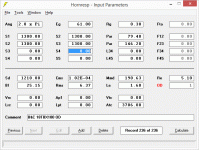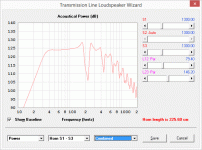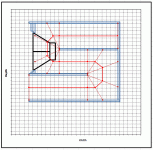kctess decided to go for xco1 build,so i don't think anyone dild it.
recently someone asked me if the 18tbw100 works in this design.it does.
so no data.
agree the ss15 fold is verry strong.
one can extend the top brace a bit.
its a more square-isch design 23 cm lower , 2cm deeper and 30 ltrs less.
grtz
recently someone asked me if the 18tbw100 works in this design.it does.
so no data.
agree the ss15 fold is verry strong.
one can extend the top brace a bit.
its a more square-isch design 23 cm lower , 2cm deeper and 30 ltrs less.
grtz
Last edited:
Can anyone think of a reason why this design won't work? It's basically a big TL with the 18TBX100 driver
Advantages:
1. Gets to 30 Hz!
2. Smaller than a TH with the same driver.
3. No chance of "port compression" effects.
4. Should be easy to build (all right angles)
5. Smooth passband up to almost 200 Hz.
Disadvantages:
1. Bigger than a vented box with same theoretical cutoff
2. 3dB less efficient in the passband than the TH design previously discussed
Attachments
Sure!
That will work 🙂
It is an OD-QWP (TL with an offset driver) .... The offset allows for wider bandwidth and sometimes also allows for a reduction in box volume ...
Should outperform a bass reflex cab, but is probably also a bit larger than a reflex cab if same tuning and similar curve in simulation ..
Advantages:
1. Gets to 30 Hz!
2. Smaller than a TH with the same driver.
3. No chance of "port compression" effects.
4. Should be easy to build (all right angles)
5. Smooth passband up to almost 200 Hz.
Disadvantages:
1. Bigger than a vented box with same theoretical cutoff
2. 3dB less efficient in the passband than the TH design previously discussed
That will work 🙂
It is an OD-QWP (TL with an offset driver) .... The offset allows for wider bandwidth and sometimes also allows for a reduction in box volume ...
Should outperform a bass reflex cab, but is probably also a bit larger than a reflex cab if same tuning and similar curve in simulation ..
That will work 🙂
It is an OD-QWP (TL with an offset driver) .... The offset allows for wider bandwidth and sometimes also allows for a reduction in box volume ...
Should outperform a bass reflex cab, but is probably also a bit larger than a reflex cab if same tuning and similar curve in simulation ..
It definitely is a bit bigger. The one below has a total volume of 13.7 cu.ft.
Go much smaller and the driver can't fit in the box, LOL
Looks a lot easier to build than a TH though.
Attachments
I built an OD-QWP. Tuning was over a very broad frequency range, with no stuffing. Not really usable for PA (which was the intended application), as it dropped from plenty of 60Hz output to a -6dB (ish) shelf down to 30Hz - much too low for a 1x15" cab. If the tuning had come up correctly, it would've had a 40Hz cutoff and a fairly flat response down to that.
There should've been an impedance peak around 75 and 25Hz, IIRC, but the lower peak came in <20Hz.
I measured the line length by drawing diagonals at each 90 degree corner. There were quite a few corners, though, so the potential for error is, I suppose, quite large.
There should've been an impedance peak around 75 and 25Hz, IIRC, but the lower peak came in <20Hz.
I measured the line length by drawing diagonals at each 90 degree corner. There were quite a few corners, though, so the potential for error is, I suppose, quite large.
Perhaps you already know of it, but just in case :
Martinsson's Blog -
Example image (not mine) :
Martinsson's Blog -
Example image (not mine) :
An externally hosted image should be here but it was not working when we last tested it.
I measured the line length by drawing diagonals at each 90 degree corner. There were quite a few corners, though, so the potential for error is, I suppose, quite large.
So you didn't use the "advanced centerline" method then?
If you drew diagonals straight across, that would introduce some errors, yes. A quick calculation suggests something like around 18% too short for each bend, compared to the "advanced centerline" method. That could add up quite significantly if there are multiple bends involved.
Apart from the loss in efficiency due to the too-long line length, how did it sound subjectively?
Hmmm....
B&C 18TBX100
Published Specs:
Fs: 34 Hz
Re: 5.1 Ohm
Qes: 0.37
Qms: 7.2
Qts: 0.35
Le: 1.6 mH
Vas: 212 l
Measured specs (one driver, DATS)
Fs: 47.1 Hz
Re: 4.76 Ohm
Qes: 0.584
Qms: 12.353
Qts: 0.557
Le: 2.3 mH
Vas: 6.4 cu.ft. (specified SPL method)
Those are some pretty different numbers. I'm going to feed a fairly large low frequency signal to it for a reasonable period of time to see if these parameters shift significantly during "break-in".
B&C 18TBX100
Published Specs:
Fs: 34 Hz
Re: 5.1 Ohm
Qes: 0.37
Qms: 7.2
Qts: 0.35
Le: 1.6 mH
Vas: 212 l
Measured specs (one driver, DATS)
Fs: 47.1 Hz
Re: 4.76 Ohm
Qes: 0.584
Qms: 12.353
Qts: 0.557
Le: 2.3 mH
Vas: 6.4 cu.ft. (specified SPL method)
Those are some pretty different numbers. I'm going to feed a fairly large low frequency signal to it for a reasonable period of time to see if these parameters shift significantly during "break-in".
So you didn't use the "advanced centerline" method then?
If you drew diagonals straight across, that would introduce some errors, yes. A quick calculation suggests something like around 18% too short for each bend, compared to the "advanced centerline" method. That could add up quite significantly if there are multiple bends involved.
Apart from the loss in efficiency due to the too-long line length, how did it sound subjectively?
See my post in the Teeny Tiny PA Subwoofer thread - the cabinet was behaving as if it had stuffing in the open end of the line, which actually lowered tuning somewhat compared to the 40Hz design cutoff.
Once the low end is EQ'd back in to account for these weird losses, the sound is good, apart from the peak at the top of the passband, around 130Hz. Notch that and all is well, with smooth bass down to the mid-30s.
It outperformed a 6th order bandpass of similar size at high SPL - I'd expect any ported box with a compromised port size to suffer a similar fate. The ports run into compression, but the transmission line just doesn't.
At lower levels, both sounded rather good, though I suspect that's in part due to the high-spec drivers used (Beyma 15P1200Nd, which I've often raved about around here). The transmission-line box just kept getting louder, but the BP6 couldn't keep up.
Chris
See my post in the Teeny Tiny PA Subwoofer thread - the cabinet was behaving as if it had stuffing in the open end of the line, which actually lowered tuning somewhat compared to the 40Hz design cutoff.
Once the low end is EQ'd back in to account for these weird losses, the sound is good, apart from the peak at the top of the passband, around 130Hz. Notch that and all is well, with smooth bass down to the mid-30s.
It outperformed a 6th order bandpass of similar size at high SPL - I'd expect any ported box with a compromised port size to suffer a similar fate. The ports run into compression, but the transmission line just doesn't.
At lower levels, both sounded rather good, though I suspect that's in part due to the high-spec drivers used (Beyma 15P1200Nd, which I've often raved about around here). The transmission-line box just kept getting louder, but the BP6 couldn't keep up.
Chris
Thanks for the feedback. It was a tough choice between the OD design and the TH design, but in the end my cousin opted for the latter. The TH requires a bigger box, and it has a higher cutoff, but I think it has an advantage wrt GD and sensitivity.
B&C 18TBX100
Published Specs:
Fs: 34 Hz
Re: 5.1 Ohm
Qes: 0.37
Qms: 7.2
Qts: 0.35
Le: 1.6 mH
Vas: 212 l
Measured specs (one driver, DATS)
Fs: 47.1 Hz
Re: 4.76 Ohm
Qes: 0.584
Qms: 12.353
Qts: 0.557
Le: 2.3 mH
Vas: 6.4 cu.ft. (specified SPL method)
...and after 45 minutes of a 15Hz signal at sufficient level to get the cone moving about 1/2 inch or so...
Fs: 42.4 Hz
Re: 4.91 Ohm
Qes: 0.56
Qms: 9.56
Qts: 0.53
Le: 2.3 mH
B&C 18TBX100
Published Specs:
Fs: 34 Hz
Re: 5.1 Ohm
Qes: 0.37
Qms: 7.2
Qts: 0.35
Le: 1.6 mH
Vas: 212 l
Measured specs (one driver, DATS)
Fs: 47.1 Hz
Re: 4.76 Ohm
Qes: 0.584
Qms: 12.353
Qts: 0.557
Le: 2.3 mH
Vas: 6.4 cu.ft. (specified SPL method)
Those are some pretty different numbers. I'm going to feed a fairly large low frequency signal to it for a reasonable period of time to see if these parameters shift significantly during "break-in".
Those are some good numbers for a Transmission design. Far better than the original parameters for your requirements. It is good to see someone measuring the parameters of the drivers they plan to use in their designs.
...and after 45 minutes of a 15Hz signal at sufficient level to get the cone moving about 1/2 inch or so...
Fs: 42.4 Hz
Re: 4.91 Ohm
Qes: 0.56
Qms: 9.56
Qts: 0.53
Le: 2.3 mH
The Q-factors are still a way out. The numbers are heading the right way, but 0.5 => 0.3 is a big jump to go...
The difference in Le is weird, too. Are you sure the measurement rig is working correctly, or are the B&C specs that far out?
Chris
Those are some good numbers for a Transmission design. Far better than the original parameters for your requirements. It is good to see someone measuring the parameters of the drivers they plan to use in their designs.
I always measure the drivers before building the box. It's much easier to correct a design when it's on paper than when it's been committed to wood 🙂.
I was planning to use this driver in a TH. The results of plugging in the measured specs into the HornResp sim for the TH suggest that it might be better if I opt for something else.
The Q-factors are still a way out. The numbers are heading the right way, but 0.5 => 0.3 is a big jump to go...
The difference in Le is weird, too. Are you sure the measurement rig is working correctly, or are the B&C specs that far out?
Chris
I'm using DATS to measure them. I'm pretty sure it's working correctly.
The club has two other 18TBX100 drivers sourced from the same supplier that are in active use at the moment. I've asked the manager to swap out one of these for one of the new ones so I can repeat the measurement on one that's been used for awhile.
I'm also going to go back to "first principles" and measure the t/s params of the new driver at higher voltage using a somewhat more tedious process that I used to use previously.
big difference
when i measure 18sound drivers ,they are always in the ballpark.
strange taht the le is so different ,you would say "a coil is a coil.
when i measure 18sound drivers ,they are always in the ballpark.
strange taht the le is so different ,you would say "a coil is a coil.
Yeah, and Re is out a bit too.
Would be interested to see how the DATS does vs more old-school methods.
Chris
Would be interested to see how the DATS does vs more old-school methods.
Chris
I always measure the drivers before building the box. It's much easier to correct a design when it's on paper than when it's been committed to wood 🙂.
I was planning to use this driver in a TH. The results of plugging in the measured specs into the HornResp sim for the TH suggest that it might be better if I opt for something else.
I see. The Tapped Horn seems to be the trend these days for home audio builders. With those parameters, I would look to wards a transmission line or reflex if you are aiming to go low.
The Q-factors are still a way out. The numbers are heading the right way, but 0.5 => 0.3 is a big jump to go...
The difference in Le is weird, too. Are you sure the measurement rig is working correctly, or are the B&C specs that far out?
Chris
Maybe suspect the driver. T/S and Le look like somebody left the shorting ring out. There are a few drivers out there now that "look" like TBX100's. I wouldn't pay $300+ for a sub driver with a 0.5 Qts.
- Status
- Not open for further replies.
- Home
- Loudspeakers
- Subwoofers
- B&C 18TBX100 DIY subwoofer design




